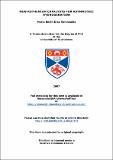Files in this item
New ruthenium catalysts for asymmetric hydrogenation
Item metadata
| dc.contributor.advisor | Clarke, Matt | |
| dc.contributor.author | Diaz Valenzuela, Maria Belen | |
| dc.coverage.spatial | 158 | en |
| dc.date.accessioned | 2008-05-15T08:53:26Z | |
| dc.date.available | 2008-05-15T08:53:26Z | |
| dc.date.issued | 2007-11 | |
| dc.identifier | uk.bl.ethos.552058 | |
| dc.identifier.uri | https://hdl.handle.net/10023/479 | |
| dc.description.abstract | A review on catalytic asymmetric hydrogenation of C=O double bonds is presented in the first chapter. Noyori’s pioneering research on ruthenium complexes containing both phosphine and diamine ligands using [i superscript]PrOH and [t superscript]BuOK is described, this system gave impressive highly chemeo-selectivity for C=O bonds and extremely high enantioselectivity for a range of acetophenone derivatives. Numerous groups have been inspired by Noyori’s catalyst of the type RuCl₂(chiraldiphosphine)(chiraldiamine), these systems often give excellent results for acetophenone. However, these catalysts have limitations, they are found to be either inactive or unselective for hydrogenation of tetralones, dialkylketones, bulky ketones, some heterocyclic ketones and imines prove difficult using this system. In this project, we are searching for a new catalyst for asymmetric hydrogenation of ketones that solve the difficult challenges faced when using Noyori’s [Ru(diphosphine)(diamine)Cl₂] catalysts system. Departing from Noyori’s type catalyst in the second chapter is described our effort to synthesise new diamines derived from amino acids and the synthesis of [Ru(diamine)(diphosphine)Cl₂] complexes. These catalysts are tested in asymmetric hydrgenation of ketones. In the next two chapters the finding of a new tridentate P^N^NH₂ type ligand is reported and the novel ruthenium complex containing the tridentate ligand has been synthesised and characterised by X-ray crystallography and been found to be active in the hydrogenation of a range of C=O and C=N double bonds, including the enantioselective hydrogenation of normally unreactive bulky ketones with up to 93 % ee. The last chapter explains the transfer hydrogenation activity for this new catalyst, involving a novel method of transfer hydrogenation reaction under microwave irradiation. | en |
| dc.format.extent | 2675 bytes | |
| dc.format.mimetype | application/pdf | |
| dc.language.iso | en | en |
| dc.publisher | University of St Andrews | |
| dc.rights | Creative Commons Attribution-NonCommercial-NoDerivs 3.0 Unported | |
| dc.rights.uri | http://creativecommons.org/licenses/by-nc-nd/3.0/ | |
| dc.subject | Catalytic asymmetric hydrogenation | en |
| dc.title | New ruthenium catalysts for asymmetric hydrogenation | en |
| dc.type | Thesis | en |
| dc.type.qualificationlevel | Doctoral | en |
| dc.type.qualificationname | PhD Doctor of Philosophy | en |
| dc.publisher.institution | The University of St Andrews | en |
This item appears in the following Collection(s)
Except where otherwise noted within the work, this item's licence for re-use is described as Creative Commons Attribution-NonCommercial-NoDerivs 3.0 Unported
Items in the St Andrews Research Repository are protected by copyright, with all rights reserved, unless otherwise indicated.


